

An encyclopedia of Middle-earth and Numenor

|
|
|
|
|
|
|
|
|
|
|
|
|
|
| |
|
 |

An encyclopedia of Middle-earth and Numenor |
 |

Source:
The Return
of the King: "The Scouring of the Shire," p. 278
Source:
The Return
of the King: "The Scouring of the Shire," p. 280
Note:
The Lord
of the Rings: A Reader's Companion speculates that a day's journey
on foot might be about 15 to 20 miles.
Source:
The Fellowship
of the Ring: "A Knife in the Dark," p. 200
The Lord
of the Rings: A Reader's Companion by Wayne G. Hammond and Christina
Scull: "A Knife in the Dark," p. 171
Names &
Etymology:
According to Tolkien, the Golden
Perch may have been popular with anglers, or fishermen, since a perch is
a type of fish.
Source:
The Fellowship
of the Ring: "A Short Cut to Mushrooms," p. 97
"Nomenclature
of The Lord of the Rings," entry for Golden Perch
Green Dragon |
The
Green Dragon from the New Line
film
|
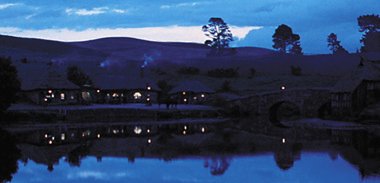 Inn
at Bywater. The Green Dragon was the last
building on the side of Bywater nearest to Hobbiton.
It was located on the Bywater Road
which linked with the Great East Road.
Hobbits from Bywater, Hobbiton, and the surrounding area came to the Green
Dragon for pints of beer and gossip.
Inn
at Bywater. The Green Dragon was the last
building on the side of Bywater nearest to Hobbiton.
It was located on the Bywater Road
which linked with the Great East Road.
Hobbits from Bywater, Hobbiton, and the surrounding area came to the Green
Dragon for pints of beer and gossip.
On April 27, 2941 of the Third Age, at the beginning of the quest to the Lonely Mountain, Thorin and Company went ahead to the Green Dragon to make preparations and await Bilbo Baggins.
One evening in early April of 3018, Sam Gamgee and Ted Sandyman, the miller's son, were at the Green Dragon. Sam spoke of strange things that had been happening, such as queer folk passing through the Shire and the Tree-man his cousin Hal claimed to have seen on the North Moors. Sam was particularly sad about the passing of the Elves westward as they left Middle-earth. Ted Sandyman scoffed at Sam's tales.
When Sam and the others returned to Bywater after the quest on November 2, 3019, they found that the windows of the inn were broken and the building looked lifeless. Six rough-looking Men lounged against the inn-wall, but the Hobbits drew their swords and the Men ran to Hobbiton for reinforcements. The next day the Men were defeated by the Hobbits in the Battle of Bywater.
Sources:
The Hobbit:
"Roast
Mutton," p. 38-39
The Fellowship
of the Ring: "The Shadow of the Past," p. 53-55
The Return
of the King: "The Scouring of the Shire," p. 283-85
Source:
The Fellowship
of the Ring: "A Long-Expected Party," p. 30-32
The Old Guesthouse was most likely used as lodgings by visitors to Minas Tirith. After most of the women and children were evacuated from the City during the War of the Ring, the boys who remained stayed in the Old Guesthouse. It was there that Pippin Took met Bergil son of Beregond on March 9, 3019 of the Third Age.
Names &
Etymology:
The Sindarin name of the Old Guesthouse
was Sennas Iaur from sennas meaning "guesthouse" and iaurmeaning
"old."
Source:
The Return
of the King: "Minas Tirith," p. 40-41
The Silmarillion:
"Appendix - Elements in Quenya and Sindarin Names," entry for iaur
The Lord
of the Rings: A Reader's Companion by Wayne G. Hammond and Christina
Scull: "Minas Tirith," p. 523
The Prancing Pony |
Sign
of the Prancing Pony in the New
Line film
|
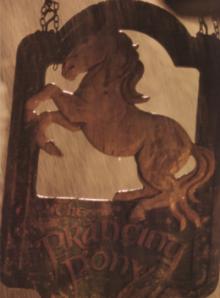 Inn
at Bree. The Prancing Pony was a meeting
place for both Bree-folk and travelers on the Great
East Road and the Greenway. The
inn was a place to hear news of the outside worlds and was frequented by
Men, Hobbits, Dwarves, and the occasional Wizard.
The art of smoking
pipe-weed was said
to have begun in Bree and from the Prancing Pony it spread among the races
of Middle-earth. The inn was also noted for its fine beer.
Inn
at Bree. The Prancing Pony was a meeting
place for both Bree-folk and travelers on the Great
East Road and the Greenway. The
inn was a place to hear news of the outside worlds and was frequented by
Men, Hobbits, Dwarves, and the occasional Wizard.
The art of smoking
pipe-weed was said
to have begun in Bree and from the Prancing Pony it spread among the races
of Middle-earth. The inn was also noted for its fine beer.
The Prancing Pony was located on the Great East Road at the base of Bree-hill. The front of the inn faced the Road and an archway led to a courtyard between two wings that ran back into the hill. The main door was to the left of the archway. A sign hung over the door with a painting of a rearing pony and the words The Prancing Pony by Barliman Butterbur. Inside there was a large Common Room, several private parlours, and a number of bedrooms, including a few rooms in the north wing designed for Hobbits that were low to the ground and had round windows. The inn also had stables.
At the time of the War of the Ring, the proprietor was Barliman Butterbur. The inn had been in his family for generations. Two Hobbits who worked for Butterbur were Nob, who was a servant in the inn, and Bob, who worked in the stables.
Two important events leading up to the War of the Ring took place at the Prancing Pony. The first was the chance meeting on March 15, 2941 of the Third Age, of Gandalf and Thorin Oakenshield, who concocted a plan to set out to recapture the Lonely Mountain from Smaug with a company of thirteen Dwarves and one Hobbit named Bilbo Baggins.
The second event occurred in 3018. On Mid-year's day of that year, Gandalf had stopped at the Prancing Pony to give Barliman Butterbur an urgent letter to be delivered to Frodo Baggins warning him to leave the Shire at once. But Barliman forgot about the letter and Frodo did not set out until September, when the Nazgul were already on his trail.
Frodo and his companions arrived at the Prancing Pony on September 29. The Prancing Pony had been recommended to them by Tom Bombadil and Merry was familiar with the inn because Brandybucks occasionally traveled to Bree and stayed there. Barliman told them they were lucky since the inn was full and only the Hobbit-sized rooms were available.
Frodo, Sam, and Pippin decided to go the the Common Room while Merry took a walk. The Common Room was crowded with Hobbits, a party of Dwarves, and a number of Men, included a squint-eyed Southerner and a hooded Ranger sitting alone. The Ranger introduced himself to Frodo as Strider and called Frodo's attention to Pippin, who was telling amusing stories about the Shire and was coming close to mentioning Bilbo's disappearance at his Farewell Party. Frodo jumped onto a table and started singing to distract the crowd, but he fell and the Ring slipped onto his finger. Among those who witnessed his sudden disappearance were the squint-eyed Southerner and Bill Ferny of Bree.
Strider revealed himself as Aragorn and Gandalf's letter was produced by an apologetic Barliman. Aragorn offered to protect the Hobbits from the Nazgul and lead them to Rivendell. He warned the Hobbits not to return to their rooms, and Nob made up the Hobbits' beds with bolsters to make it appear that they were sleeping.
The inn was attacked in the night and the Hobbits' empty beds were slashed and their rooms ransacked. The stable doors were opened and Merry's five ponies were lost. The Hobbits left Bree the next morning, and when Gandalf arrived later that day and learned that Aragorn had gone with them he placed a seven-year enchantment of excellence on the inn's beer.
Despite this, business at the Prancing Pony declined over the next year because of an influx of rough Men from the South who terrorized Bree and the surrounding countryside. But Gandalf and the Hobbits stopped at the Prancing Pony on their way home in October of 3019 to tell Barliman that the war was over and that people would soon be traveling up the road to his inn once more.
Sources:
The Fellowship
of the Ring: "Prologue: Concerning Pipeweed," p. 17; "Fog on the Barrow-downs,"
p. 159; "At the Sign of the Prancing Pony," passim; "Strider," passim;
"A Knife in the Dark," p. 189-92; "The Council of Elrond," p. 276-77
The Return
of the King: "Homeward Bound," p. 269-74
Appendix
A of The Lord of the Rings: "Durin's Folk," p. 358-59
When King Eomer of Rohan returned to Minas Tirith on July 18, 3019 of the Third Age, a feast was held in the Great Hall.
Names &
Etymology:
Also called Merethrond meaning
"feast hall" from mereth meaning "feast" and rond meaning
"a large hall or chamber with a vaulted roof."
Sources:
The Return
of the King: "Many Partings," p. 253
The History
of Middle-earth, vol. IX, Sauron Defeated: "Many Partings," p. 67
The Silmarillion:
"Appendix - Elements in Quenya and Sindarin Names," entries for mereth
and rond
Houses of Healing |
Eowyn
and Faramir in the Houses of Healing
in the New Line film |
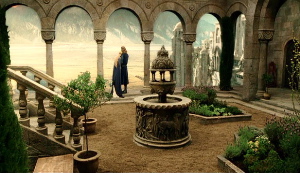 Hospital
facility in Minas Tirith. In the Houses
of Healing, the sick and wounded were cared for by highly skilled healers,
including a number of women. Many different herbs with healing properties
were kept there in the charge of an herb-master. The Warden of the Houses
of Healing was the chief of the healers.
Hospital
facility in Minas Tirith. In the Houses
of Healing, the sick and wounded were cared for by highly skilled healers,
including a number of women. Many different herbs with healing properties
were kept there in the charge of an herb-master. The Warden of the Houses
of Healing was the chief of the healers.
The Houses of Healing were located in the southeastern part of the sixth level of the City near the gate to the Citadel. There were several houses with a number of rooms for patients. The Warden's room faced eastward. The spacious gardens around the Houses were unique in the City, and from their walls one could look eastward across the Anduin.
On March 15, 3019 of the Third Age, many of the wounded from the Battle of the Pelennor Fields were brought to the Houses of Healing. The three most grievously wounded patients were Faramir, Eowyn, and Merry Brandybuck, who were all gravely ill as a result of their contact with the Nazgul. Aragorn asked the wise-woman Ioreth and the herb-master for athelas, but none was kept in the Houses for it was not known to have healing properties. At last some leaves were found in the City and Aragorn used it to revive the three patients.
The three patients remained in the Houses of Healing while Aragorn led the Host of the West to the Black Gate. Eowyn wished to leave the Houses of Healing and ride into battle soon after she awoke, but the Warden would not allow it. She appealed to Faramir but he agreed with the Warden, though he granted her desire to look eastward by inviting her to walk in the gardens. On March 25, Eowyn and Faramir were standing at the garden wall looking toward Mordor when the Shadow departed and the realm of Sauron fell.
Eowyn remained in the Houses of Healing for several days, troubled by her feelings for Aragorn. The Warden was worried about his patient and sent for Faramir. In the gardens of the Houses of Healing, Faramir asked Eowyn to marry him and at last she realized her true feelings and accepted. The Warden released her from his care, but Eowyn chose to remain in the Houses of Healing until her brother Eomer returned to Minas Tirith.
Names &
Etymology:
The Sindarin name of the Houses
of Healing may have been Bair Nestad or Bair Nestedrin. The
word bair means "houses" from the singular bar. The word
nestad
means "healing," the gerund form of the verb nesta meaning "to heal."
The word nestedrin is probably the plural adjectival form; in the
text of HoME VIII it is written as
nestedriu,
but this may be a transcription error.
Sources:
The Return
of the King: "The Pyre of Denethor," p. 131-32; "The Houses of Healing,"
passim; "The Steward and the King," p. 236-43
The History
of Middle-earth, vol. VIII, The War of the Rings: "The Pyre of Denethor,"
p. 379-80
Suggested
Conjugation of All Known Sindarin Verbs by Helge Kåre Fauskanger
Erreurs
probables dans les Etymologies: Appendice by Didier Willis
The prisoners who were sent to the Lockholes were not well-fed, and after Saruman took over they were even beaten. The cells were dark and narrow. On November 4, 3019, Frodo Baggins released the prisoners.
Sources:
The Return
of the King: "The Scouring of the Shire," p. 281, 288, 292; "The Grey
Havens," p. 301
The most precious item in the museum's collection was the mithril shirt belonging to Bilbo Baggins. Bilbo loaned the coat of mail to the Mathom-house sometime after returning from the Lonely Mountain in 2942 of the Third Age. He reclaimed the mithril shirt in 3001 when he left the Shire.
Names &
Etymology:
The word mathom is from the
Old English máðm meaning "precious thing, treasure."
Sources:
The Fellowship
of the Ring: "Prologue: Concerning Hobbits," p. 14-15; "Prologue: Of
the Finding of the Ring," p. 22-23; "The Ring Goes South," p. 291; "A Journey
in the Dark," p. 331
The Mill |
The
Mill in Hobbiton in the New Line
film
|
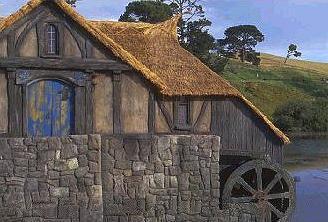 Mill
owned by the Sandyman family in
Hobbiton.
The Mill was on the north bank of the Water
by the bridge. The Mill had a large water-wheel and a yard was located
behind it. Sandyman the Miller
owned the Mill and operated it with the help of his son Ted.
The Mill was used for grinding corn.
Mill
owned by the Sandyman family in
Hobbiton.
The Mill was on the north bank of the Water
by the bridge. The Mill had a large water-wheel and a yard was located
behind it. Sandyman the Miller
owned the Mill and operated it with the help of his son Ted.
The Mill was used for grinding corn.
Lotho Sackville-Baggins bought the Mill sometime before he moved to Bag End in Hobbiton in September 3018 of the Third Age. After Frodo Baggins and his companions left the Shire, Lotho had the Old Mill knocked down and built the New Mill in its place. The New Mill was an ugly red-brick building with a tall chimney. It was bigger than the Old Mill and full of wheels and strange contraptions to increase production. The New Mill straddled the Water and poured pollutants into the stream.
The New Mill was operated by Men and Ted Sandyman stayed on to help them. When Saruman came to the Shire in September of 3019, the Mill was no longer used for grinding corn. Instead it was used for some industrial purpose and loud noises, smoke, and filth issued from it.
After Saruman was killed and the Chief's Men were defeated at the Battle of Bywater, the New Mill was removed.
Sources:
The Hobbit:
Illustration of "The Hill: Hobbiton-across-The Water"
The Fellowship
of the Ring: "A Long-Expected Party," p. 31-32; "The Shadow of the
Past," p. 53; "The Mirror of Galadriel," p. 378
The Return
of the King: "The Scouring of the Shire," p. 291-93; 296-97; "The Grey
Havens," p. 302
Old GrangeGranary in Hobbiton. The Old Grange was located on the west side of the path leading from the Water to the Hill. The Old Grange was probably used to store the grain for the Mill nearby. During the War of the Ring, the Old Grange was torn down and replaced by rows of tarred sheds.Sources:
|
The
Old Grange by J.R.R. Tolkien
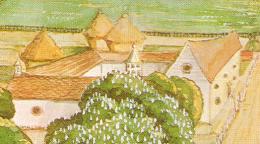 |
Source:
The Fellowship
of the Ring: "At the Sign of the Prancing Pony," p. 168
All entries are Copyright © by the Thain from former tuckborough.net. Please contact me if you are Thain or know anything about how to contact the original author.
2003-2011, The Thain's Book - thainsbook.minastirith.cz
- e-mail: thain at tuckborough.net